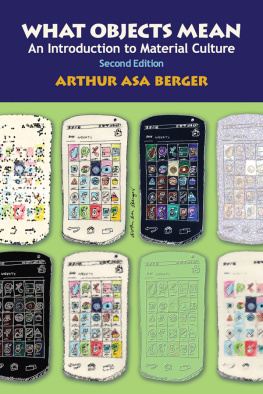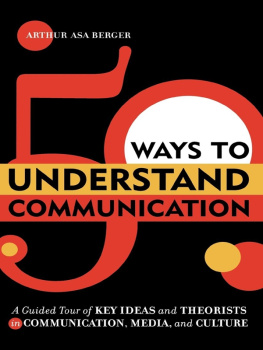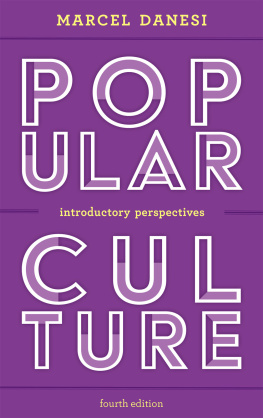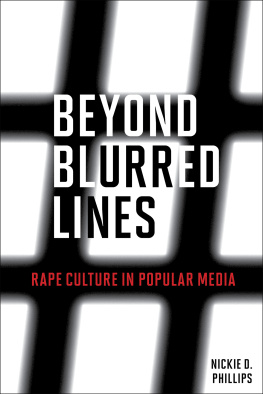First published 1996 by Transaction Publishers
Published 2017 by Routledge
2 Park Square, Milton Park, Abingdon, Oxon OX14 4RN
711 Third Avenue, New York, NY 10017, USA
Routledge is an imprint of the Taylor & Francis Group, an informa business
All rights reserved. No part of this book may be reprinted or reproduced or utilised in any form or by any electronic, mechanical, or other means, now known or hereafter invented, including photocopying and recording, or in any information storage or retrieval system, without permission in writing from the publishers.
Notice:
Product or corporate names may be trademarks or registered trademarks, and are used only for identification and explanation without intent to infringe.
Library of Congress Catalog Number: 95-37827
Library of Congress Cataloging-in-Publication Data
Berger, Arthur Asa, 1933-3
Manufacturing desire : media, popular culture, and everyday life / Arthur Asa Berger.
p. cm.
Includes bibliographical references and index.
ISBN 1-56000-226-3 (alk. paper)
1. Mass media and culture&United States. 2. Popular culture&United States. I. Title.
P94.6.B47 1995
302.230973dc20
95-37827
CIP
ISBN 13: 978-1-4128-0765-4 (pbk)
ISBN 13: 978-1-56000-226-0 (hbk)
For David W. Noble
Contents
Acknowledgments
I would like to thank Mary Curtis, who suggested I do this book, and all the people at Transaction Publishers, who have done such a professional job of publishing it. Ive had a long and happy relationship with Irving Louis Horowitz and Mary Curtis and their colleagues at Transaction Publishers, and have appreciated their friendship and encouragement over the past twenty years.
Ive benefitted from the work (and in some cases the friendship and support) of a number of people and would like to acknowledge my appreciation by naming some of them: Aaron and Mary Wildavsky, David Noble, Mulford Q. Sibley, Ralph Ross, Sigmund Freud, Karl Marx, Groucho Marx, Stan Lee, Umberto Eco, Roland Barthes, Claude Lvi-Strauss, George Gerbner, Michael Real, Vladimir Propp, Ferdinand de Saussure, Victor and Leoni Rosonoer, Stanley Milgram, Marshall McLuhan, Jean-Marie Benoist, Isaac and Roz Silberman, Peter Clarke, Mike Noll, Daniel Dayan, Elihu Katz, Chaim Eyal, Ron Compesi, Stuart Hyde, Herbert Zettl, Howard and Barbara Ginsberg, Maxwell Henry Goldberg, Kim Schroder, Karl Erik Rosengren, Steen Sauerberg, Klaus Bruhn Jensen, Bo Reimer, Giusseppe Gadda Conti, Mary Douglas, David Manning White, Richard Hoggart, Johan Huizinga, Bronislaw Malinowski, Margin Grotjahn, Vyacheslav Ivanov, Mircea Eliade, Agostino Lombardo, M. M. Bakhtin, Fustel de Coulanges, and Yuri Lotman.
I am grateful to the following publishers for allowing me to reprint a number of articles that appeared earlier (I have revised most of them for this book): the Haworth Press for Of Mice and Men; The International Society for General Semantics for Eleven Ways of Looking at the Gulf War; and Longman Publishers for my article The Manufacture of Desire. My article Comics and Popular Culture: Not Just Kids Stuff appeared in the July, 1990 issue of The World & I, and my article Funnies are Good for Us appeared in the May, 1992 issue of The World & I, and are reprinted with permission of The World & I, a publication The Washington Times Corporation, copyright 1990, 1992. My article Texts in Contexts appeared in F. Korzenny and S. Ting Toomey, Mass Media Effects Across Cultures, 1992 and is reprinted by permission of Sage Publications. My articles 1984: The Commercial, The Terminator, and Popular Culture and The Public Arts, (originally published at the introduction to the recent Transaction edition of Gilbert Seldes, The Public Arts) are published with permission of Transaction Publishers. My article Whats in a Joke? appeared in Elementa: Journal of Slavic Studies & Comparative Cultural Semiotics (vol. 1, no. 3, 1994) and is reprinted by permission of Harwood Academic Publishers. My article The Semiotics of Public and Private Space appeared in Media Development (vol. 37, March 1990). The other chapters were written specifically for this book.
When I published Television as an Instrument of Terror in 1980, I was ambivalent about the term terror. I used it, first of all, as a grabber, as something to attract peoples attention, but also because I thought television had revolutionary and subversive powers that people, as a rule, didnt recognize. I had used the title once before, in the first of a number of columns I wrote for Focus magazine, published by public television station KQED in San Francisco.
Television as a Mindless Medium
For most people then (and perhaps now) television was seen as a rather mindless medium of entertainment and, therefore, not terribly important in the scheme of things. The idea of connecting television and terror seemed rather preposterous. Television called to mind situation comedies, variety shows, sports shows, news programs, and commercials; silly stuff, for the most part. Where do you find the terror?
I found terror in the hidden compulsions that television spread, in the bodies of the actresses and models in commercials that gave men a ridiculous view of what women were supposed to look like and made ordinary women feel that there was something wrong with them, and in the upper-middle-class visions of the good life that television portrayed as normal, thereby suggesting that all who did not have the so-called good things in life were somehow deficient. That was before little children had been taught by television to be conscious of brand names and before adolescents started killing one another for $150 sneakers.
I saw television (and other media as well as the popular art works carried on them) as inflicting a reign of terror on people, which was all the worse since people didnt not recognize what was happening to them.
All they knew is that they were uneasy about what they had achieved and what they could expect and seemed trapped, all too often, in a vicious cycle of insatiable consumer lust, endless debt, and a corrosive sense of envy (or, in sociological terms, relative deprivation).
I suggested that television was an instrument of terror, the primary instrument of terror, because it was the dominant medium of the day. It still is. Recent figures suggest the average person in America watches four hours of television per day and spends the equivalent of nine years of his or her life in front of the television set. Television, as an audio-visual medium, has the greatest impact on individuals of all the daily media; only film, shown in movie houses with relatively huge images and high-fidelity sound, has a more powerful visceral effect.
As I wrote in my column, The Last Word (in August, 1976):
The measure of televisions power is that hardly anyone is aware of itthough they may watch it five or six hours a dayand young people, even adolescents, cannot imagine what life was like before television. (What did people









